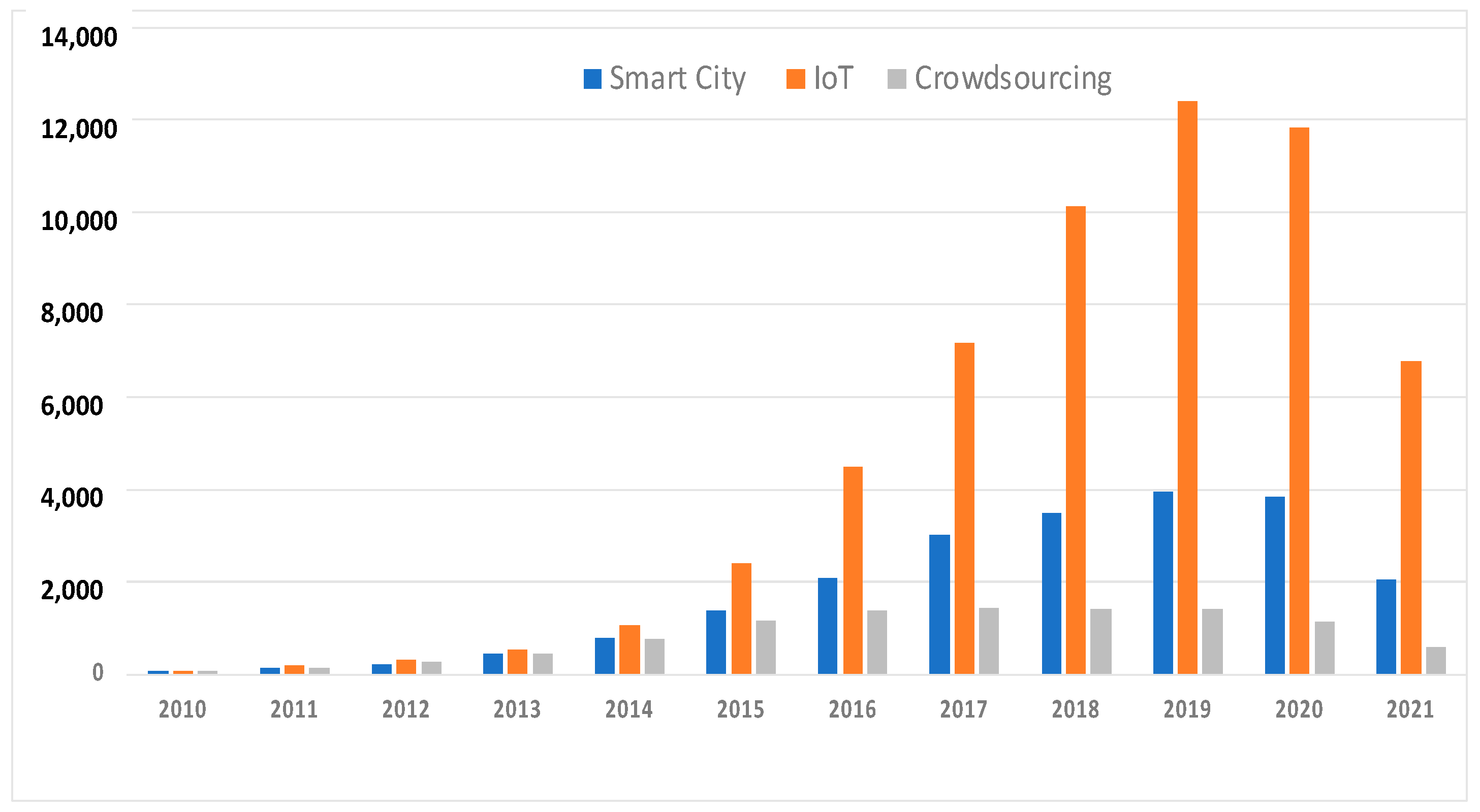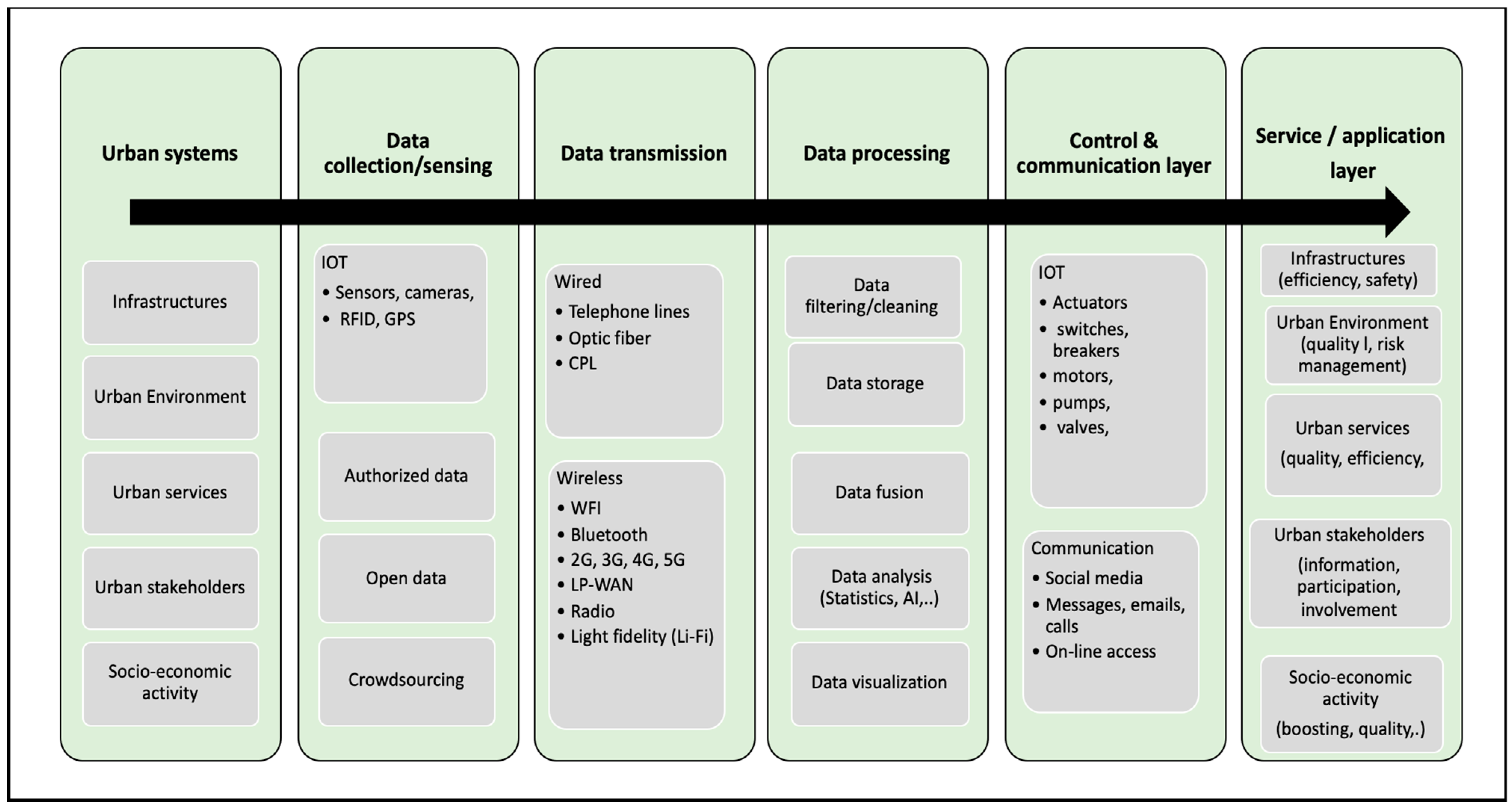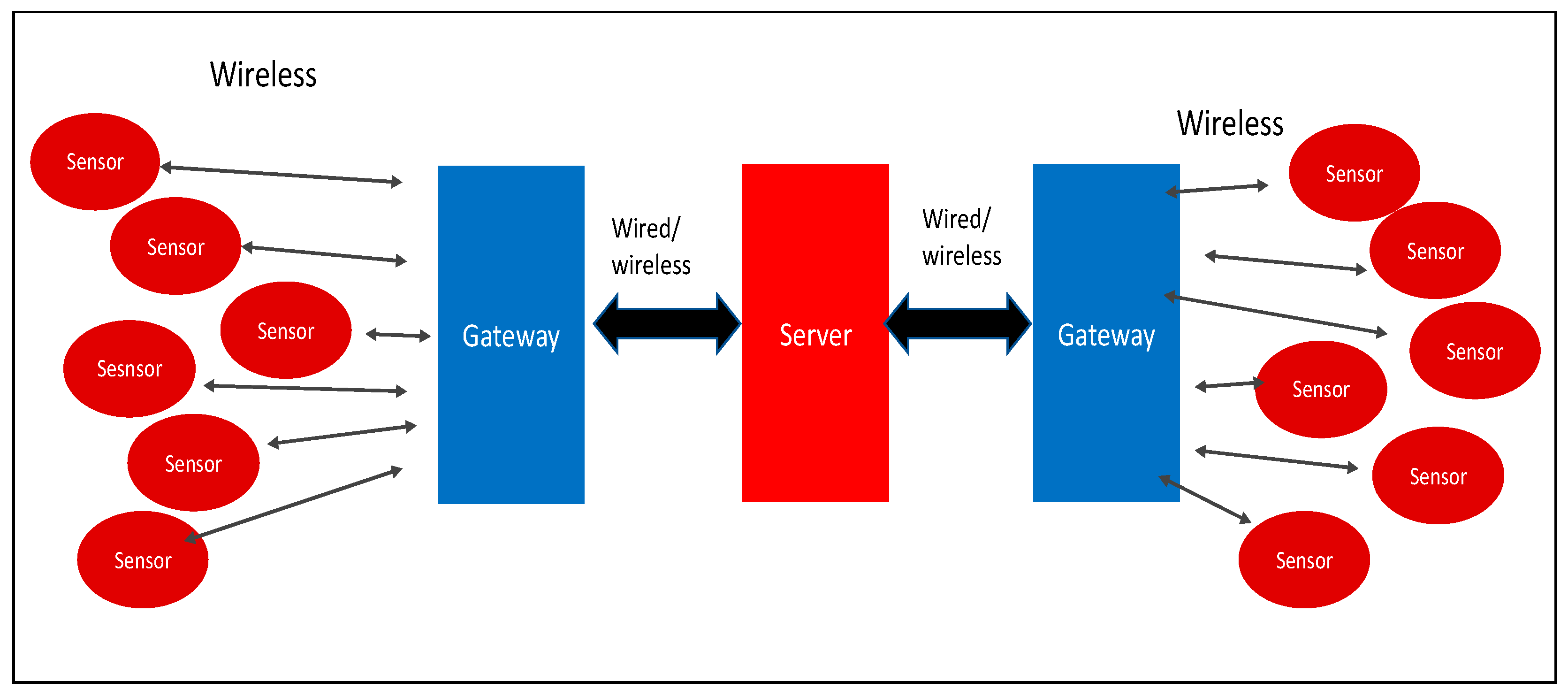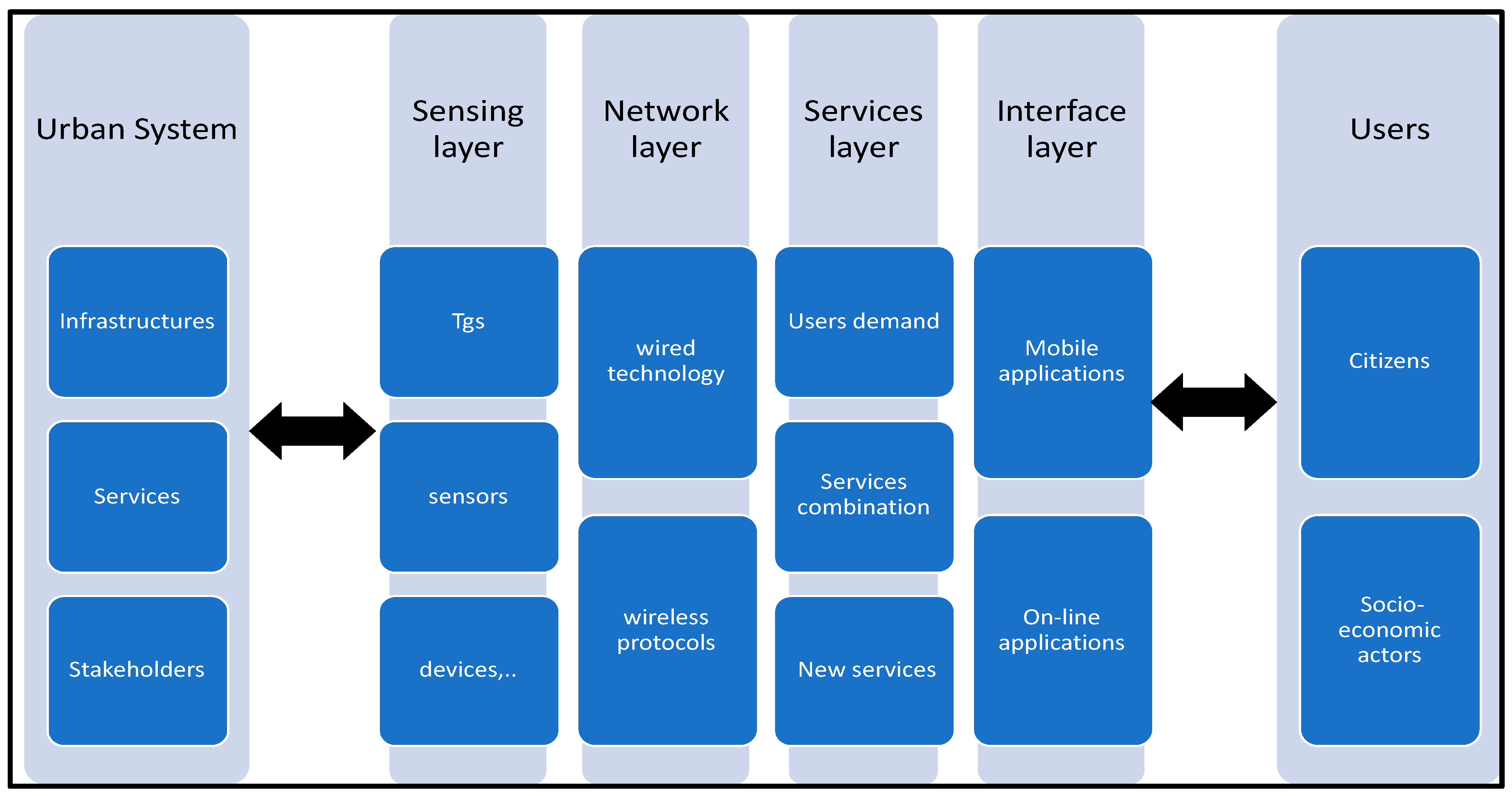Role of Internet of Things (IoT) and Crowdsourcing in Smart City Projects
Abstract
:1. Introduction
2. Materials and Methods
3. Smart City
3.1. Concepts and Frameworks
3.2. Smart City Data
3.3. Smart City Architecture
4. The Internet of Things (IoT)
4.1. Definition and Technology
4.2. Use of the IoT in Innovative City Applications
4.3. Security and Privacy
4.4. Challenges for the Use of the IoT in Smart City Applications
5. Crowdsourcing
5.1. Overview
5.2. Mobile Crowdsourcing
5.3. Crowdsourcing in Smart City Applications
6. Conclusions
- Most academic papers about smart cities focus on the smart city concept and its role in improving the quality of life, urban governance, infrastructures efficiency, and the urban environment. Some papers criticized the ICT-centered smart city concepts and highlighted the necessity to extend these concepts to include citizen-centered concerns. However, a significant lack is observed in the feedback from real smart city projects. This lack could be attributed to the youngness and fragmentation of smart city projects and the lack of cooperation among cities, corporations, and academics.
- An impressive scientific development in the field of the IoT and a high perspective of the use of the IoT in smart city transformations, with, however the following challenges: heterogeneity of the IoT components and protocols, self-configurability for automatic configuration in case of modification or perturbation to the IoT systems, extensibility for easy extension in the IoT system to include new functions or technologies, context awareness to enhance the capability to detect and react to changes in the surrounding environment, and security to protect IoT devices and applications from malicious attacks.
- Developing the smart city still requires stronger cooperation between the smart city technology-centered research, mainly based on the IoT, and the smart city citizens-centered research, mainly based on crowdsourcing; this cooperation could benefit in recent developments in the field of crowdsensing that combine the IoT and crowdsourcing.
- An excellent perspective for mobile crowdsourcing to support citizens’ implication in local development and strengthen participatory governance. Mobile crowdsourcing could also accelerate the implementation of smart city projects by developing crowdsourcing-based and cost-effective monitoring systems as an alternative to conventional smart city monitoring systems.
Author Contributions
Funding
Conflicts of Interest
References
- Moustaka, V.; Vakali, A.; Anthopoulos, L.G. A systematic review for smart city data analytics. ACM Comput. Surv. 2019, 51, 1–41. [Google Scholar] [CrossRef]
- Kourtit, K.; Elmlund, P.; Nijkamp, P. The urban data deluge: Challenges for smart urban planning in the third data revolution. Int. J. Urban Sci. 2020, 24, 445–461. [Google Scholar] [CrossRef]
- Caceres, P.; Sierra-Alonso, A.; Cuesta, C.E.; Vela, B.; Barca, J.M.C. Improving urban mobility by defining a smart data integration platform. IEEE Access 2020, 8, 204094–204113. [Google Scholar] [CrossRef]
- Moustaka, V.; Maitis, A.; Vakali, A.; Anthopoulos, L. Urban data dynamics: A systematic benchmarking framework to integrate crowdsourcing and smart cities’ standardization. Sustainability 2021, 13, 8553. [Google Scholar] [CrossRef]
- Iqbal, A.; Olariu, S. A survey of enabling technologies for smart communities. Smart Cities 2020, 4, 54–77. [Google Scholar] [CrossRef]
- Hernández-Gordillo, A.; Ruiz-Correa, S.; Robledo-Valero, V.; Hernández-Rosales, C.; Arriaga, S. Recent advancements in low-cost portable sensors for urban and indoor air quality monitoring. Air Qual. Atmos. Health 2021, 2021, 1–21. [Google Scholar] [CrossRef]
- Alvear, O.; Calafate, C.T.; Cano, J.-C.; Manzoni, P. Crowdsensing in smart cities: Overview, platforms, and environment sensing issues. Sensors 2018, 18, 460. [Google Scholar] [CrossRef] [PubMed] [Green Version]
- Ganti, R.K.; Ye, F.; Lei, H. Mobile crowdsensing: Current state and future challenges. IEEE Commun. Mag. 2011, 49, 32–39. [Google Scholar] [CrossRef]
- Kong, X.; Liu, X.; Jedari, B.; Li, M.; Wan, L.; Xia, F. Mobile crowdsourcing in smart cities: Technologies, applications, and future challenges. IEEE Internet Things J. 2019, 6, 8095–8113. [Google Scholar] [CrossRef]
- EIP-SCC. European Innovation Partnership for Smart Cities and Communities. Available online: https://ec.europa.eu/info/eu-regional-and-urban-development/topics/cities-and-urban-development/city-initiatives/smart-cities_en#european-innovation-partnership-on-smart-cities-and-communities (accessed on 20 February 2020).
- Deloitte. Super Smart City: Happier Society with Higher Quality; Deloitte China: Beijing, China, 2018; Available online: https://www2.deloitte.com/cn/en/pages/public-sector/articles/super-smart-city.html (accessed on 21 September 2021).
- Hu, R. The state of smart cities in China: The case of Shenzhen. Energies 2019, 12, 4375. [Google Scholar] [CrossRef] [Green Version]
- Government of India Ministry of Urban Development. India Smart City. Smart Cities Mission Statement & Guidelines. 2015. Available online: http://smartcities.gov.in/upload/uploadfiles/files/SmartCityGuidelines(1).pdf (accessed on 20 February 2020).
- Olariu, S. Vehicular crowdsourcing for congestion support in smart cities. Smart Cities 2021, 4, 662–685. [Google Scholar] [CrossRef]
- Kuru, K.; Ansell, D. TCitySmartF: A comprehensive systematic framework for transforming cities into smart cities. IEEE Access 2020, 8, 18615–18644. [Google Scholar] [CrossRef]
- Alhalabi, W.; Lytras, M.; Aljohani, N. Crowdsourcing research for social insights into smart cities applications and services. Sustainability 2021, 13, 7531. [Google Scholar] [CrossRef]
- Hall, P. Creative cities and economic development. Urban Stud. 2000, 37, 639–649. [Google Scholar] [CrossRef]
- Shapiro, J. Smart Cities: Explaining the Relationship Between City Growth and Human Capital; Harvard University Press: Cambridge, MA, USA, 2003. [Google Scholar]
- Komninos, N. The architecture of intelligent cities: Integrating human, collective and artificial intelligence to enhance knowledge and innovation. In Proceedings of the 2nd IET International Conference on Intelligent Environments (IE 06), Athens, Greece, 5–6 July 2006. [Google Scholar]
- Giffinger, R.; Fertner, C.; Kramar, H.; Kalasek, R.; Pichler-Milanovic, N.; Meijers, E. Smart Cities: Ranking of European Medium-Sized Cities; Center of Regional Science (SRF): Vienna, Austria, 2007. [Google Scholar]
- Hollands, R.G. Will the real smart city please stand up? City 2008, 12, 303–320. [Google Scholar] [CrossRef]
- Paskaleva, K.A. Enabling the smart city: The progress of city e-governance in Europe. Int. J. Innov. Reg. Dev. 2009, 1, 405. [Google Scholar] [CrossRef]
- Toppeta, D. The Smart City Vision: How Innovation and ICT Can Build Smart, “Livable”, Sustainable Cities. The Innovation Knowledge Foundation. 2010. Available online: http://www.thinkinnovation.org/file/research/23/en/Toppeta_Report_005_2010.pdf (accessed on 1 July 2021).
- Harrison, C.; Donnelly, I.A. A theory of smart cities. In Proceedings of the 55th Annual Meeting of the International Society for the Systems Sciences, University of Hull Business School, Hull, UK, 17–22 July 2011; Available online: http://journals.isss.org/index.php/proceedings55th/issue/view/11 (accessed on 1 July 2021).
- Caragliu, A.; del Bo, C.; Nijkamp, P. Smart cities in Europe. J. Urban Technol. 2011, 18, 65–82. [Google Scholar] [CrossRef]
- Locat, J.; Leroueil, S.; Locat, A.; Lee, H. Weak layers: Their definition and classification from a geotechnical perspective. In Submarine Mass Movements and Their Consequences. Advances in Natural and Technological Hazards Research; Krastel, S., Ed.; Springer: Dordrecht, The Netherlands, 2014; Volume 37, pp. 3–12. [Google Scholar] [CrossRef]
- Chourabi, H.; Nam, T.; Walker, S.; Gil-Garcia, J.R.; Mellouli, S.; Nahon, K.; Pardo, T.A.; Scholl, H.J. Understanding smart cities: An integrative framework. In Proceedings of the 45th Hawaii International Conference on System Science (HICSS), Maui, HI, USA, 4–7 January 2012; pp. 2289–2297. [Google Scholar]
- Kitchin, R. Making sense of smart cities: Addressing present shortcomings. Camb. J. Reg. Econ. Soc. 2014, 8, 131–136. [Google Scholar] [CrossRef] [Green Version]
- Neirotti, P.; de Marco, A.; Cagliano, A.C.; Mangano, G.; Scorrano, F. Current trends in smart city initiatives: Some stylised facts. Cities 2014, 38, 25–36. [Google Scholar] [CrossRef] [Green Version]
- Anthopoulos, L. Understanding the Smart City Domain: A Literature Review in Transforming City Governments for Successful Smart Cities; Springer: Berlin/Heidelberg, Germany, 2015. [Google Scholar]
- Hiremath, R.B.; Balachandra, P.; Kumar, B.; Bansode, S.S.; Murali, J. Indicator based urban sustainability: A review. Energy Sustain. Dev. 2013, 17, 555–563. [Google Scholar] [CrossRef]
- Neumann, H.M.; Pangerl, E.; Airaksinen, M.; Ahvenniemi, H.; Bosch, P.; DeCunto, A.; Zueger, J. Measuring the performance of smart cities in Europe. In Proceedings of the First WBCSD and EMAN Joint International Sustainability Accounting Sympo-Sium, Geneva, Switzerland, 1–2 October 2015. [Google Scholar]
- Zdraveski, V.; Mishev, K.; Trajanov, D.; Kocarev, L. ISO-standardized smart city platform architecture and dashboard. IEEE Pervasive Comput. 2017, 16, 35–43. [Google Scholar] [CrossRef]
- International Standards Organization. ISO Std. 37120:2014, Sustainable Development of Communities-Indicators for City Services and Quality of Life. 2014. Available online: https://www.iso.org/standard/62436.html (accessed on 20 February 2020).
- Allam, Z.; Newman, P. Redefining the smart city: Culture, metabolism and governance. Smart Cities 2018, 1, 4–25. [Google Scholar] [CrossRef] [Green Version]
- Dameri, R.P. Searching for smart city definition: A comprehensive proposal. Int. J. Comput. Technol. 2013, 11, 2544–2551. [Google Scholar] [CrossRef]
- Mora, L.; Bolici, R.; Deakin, M. The first two decades of smart-city research: A bibliometric analysis. J. Urban Technol. 2017, 24, 3–27. [Google Scholar] [CrossRef]
- Yigitcanlar, T.; Kamruzzaman, M.; Buys, L.; Ioppolo, G.; Sabatini-Marques, J.; da Costa, E.M.; Yun, J.J. Understanding ‘smart cities’: Intertwining development drivers with desired outcomes in a multidimensional framework. Cities 2018, 81, 145–160. [Google Scholar] [CrossRef]
- Paiva, S.; Ahad, M.; Tripathi, G.; Feroz, N.; Casalino, G. Enabling technologies for urban smart mobility: Recent trends, opportunities and challenges. Sensors 2021, 21, 2143. [Google Scholar] [CrossRef] [PubMed]
- Khatibi, H.; Wilkinson, S.; Baghersad, M.; Dianat, H.; Ramli, H.; Suhatril, M.; Javanmardi, A.; Ghaedi, K. The resilient—Smart city development: A literature review and novel frameworks exploration. Built Environ. Proj. Asset Manag. 2021. ahead of printing. [Google Scholar] [CrossRef]
- Han, M.J.N.; Kim, M.J. A critical review of the smart city in relation to citizen adoption towards sustainable smart living. Habitat Int. 2021, 108, 102312. [Google Scholar] [CrossRef]
- Lopez, L.R.; Castro, A.G. Sustainability and resilience in smart city planning: A review. Sustainability 2020, 13, 181. [Google Scholar] [CrossRef]
- Zekić-Sušac, M.; Mitrović, S.; Has, A. Machine learning based system for managing energy efficiency of public sector as an approach towards smart cities. Int. J. Inf. Manag. 2021, 58, 102074. [Google Scholar] [CrossRef]
- Chen, D.; Wawrzynski, P.; Lv, Z. Cyber security in smart cities: A review of deep learning-based applications and case studies. Sustain. Cities Soc. 2021, 66, 102655. [Google Scholar] [CrossRef]
- Miah, S.J.; Vu, H.Q. Towards developing a healthcare situation monitoring method for smart city initiatives. Australas. J. Inf. Syst. 2020, 24, 1–7. [Google Scholar] [CrossRef]
- Ghazal, T.M.; Hasan, M.K.; Alshurideh, M.T.; Alzoubi, H.M.; Ahmad, M.; Akbar, S.S.; Al Kurdi, B.; Akour, I.A. IoT for smart cities: Machine learning approaches in smart healthcare—A review. Futur. Internet 2021, 13, 218. [Google Scholar] [CrossRef]
- Barnaghi, P.; Bermudez-Edo, M.; Tönjes, R. Challenges for quality of data in smart cities. J. Data Inf. Qual. 2015, 6, 1–4. [Google Scholar] [CrossRef]
- Mahdavinejad, M.S.; Rezvan, M.; Barekatain, M.; Adibi, P.; Barnaghi, P.; Sheth, A.P. Machine learning for internet of things data analysis: A survey. Digit. Commun. Netw. 2018, 4, 161–175. [Google Scholar] [CrossRef]
- Aguilera, U.; Peña, O.; Belmonte, O.; López-De-Ipiña, D. Citizen-centric data services for smarter cities. Futur. Gener. Comput. Syst. 2017, 76, 234–247. [Google Scholar] [CrossRef] [Green Version]
- Shahrour, I.; Abbas, O.; Abdallah, A.; Rjeily, Y.A.; Afaneh, A.; Aljer, A.; Ayari, B.; Farrah, E.; Sakr, D.; Al Masri, F. Lessons from a large scale demonstrator of the smart and sustainable city. In Biotechnology Business—Concept to Delivery; Springer Science and Business Media LLC: Berlin/Heidelberg, Germany, 2017; Volume 42, pp. 193–206. [Google Scholar]
- Silva, B.N.; Khan, M.; Han, K. Towards sustainable smart cities: A review of trends, architectures, components, and open challenges in smart cities. Sustain. Cities Soc. 2018, 38, 697–713. [Google Scholar] [CrossRef]
- Bandyopadhyay, D.; Sen, J. Internet of things: Applications and challenges in technology and standardization. Wirel. Pers. Commun. 2011, 58, 49–69. [Google Scholar] [CrossRef]
- Mulligan, C.E.A.; Olsson, M. Architectural implications of smart city business models: An evolutionary perspective. IEEE Commun. Mag. 2013, 51, 80–85. [Google Scholar] [CrossRef]
- LoRa Specification. Available online: https://www.rs-online.com/designspark/rel-assets/ds-assets/uploads/knowledge-items/application-notes-for-the-internet-of-things/LoRaWAN%20Specification%201R0.pdf (accessed on 22 February 2020).
- Sigfox. Available online: https://www.sigfox.com/en/what-sigfox/technolog (accessed on 22 February 2020).
- Gomez, C.; Oller, J.; Paradells, J. Overview and evaluation of bluetooth low energy: An emerging low-power wireless tech-nology. Sensors 2012, 12, 11734–11753. [Google Scholar] [CrossRef]
- Ejaz, W.; Anpalagan, A.; Imran, M.A.; Jo, M.; Naeem, M.; Bin Qaisar, S.; Wang, W. Internet of Things (IoT) in 5G wireless communications. IEEE Access 2016, 4, 10310–10314. [Google Scholar] [CrossRef]
- Silva, B.N.; Khan, M.; Han, K. Internet of Things: A comprehensive review of enabling technologies, architecture, and challenges. IETE Tech. Rev. 2017, 35, 205–220. [Google Scholar] [CrossRef]
- Hall, D.L.; Llinas, J. An introduction to multisensor data fusion. Proc. IEEE 1997, 85, 6–23. [Google Scholar] [CrossRef] [Green Version]
- Mayer-Schönberger, V.; Cukier, K. Big Data: A Revolution that Will Transform How We Live, Work, and Think; Houghton Mifflin Harcourt: Boston, MA, USA, 2013. [Google Scholar]
- Chen, M.; Mao, S.; Liu, Y. Big data: A survey. Mob. Netw. Appl. 2014, 19, 171–209. [Google Scholar] [CrossRef]
- Al Nuaimi, E.; Al Neyadi, H.; Mohamed, N.; Al-Jaroodi, J. Applications of big data to smart cities. J. Internet Serv. Appl. 2015, 6, 25. [Google Scholar] [CrossRef] [Green Version]
- Farah, E.; Shahrour, I. Leakage detection using smart water system: Combination of water balance and automated minimum night flow. Water Resour. Manag. 2017, 31, 4821–4833. [Google Scholar] [CrossRef]
- Saab, C.; Shahrour, I.; Chehade, F.H. Risk assessment of water accidental contamination using smart water quality monitoring. Expo. Health 2019, 12, 281–293. [Google Scholar] [CrossRef]
- Rjeily, Y.A.; Abbas, O.; Sadek, M.; Shahrour, I.; Chehade, F.H. Flood forecasting within urban drainage systems using NARX neural network. Water Sci. Technol. 2017, 76, 2401–2412. [Google Scholar] [CrossRef]
- Shahrour, I.; Bian, H.; Xie, X.; Zhang, Z. Use of smart technology to improve management of utility tunnels. Appl. Sci. 2020, 10, 711. [Google Scholar] [CrossRef] [Green Version]
- ISO/IEC. Smart Cities, Preliminary Report 2014. 2015. Available online: https://www.iso.org/files/live/sites/isoorg/files/developing_standards/docs/en/smart_cities_report-jtc1.pdf (accessed on 20 February 2020).
- International Telecommunication Union (ITU). Series Y: Global Information Infrastructure, Internet Protocol Aspects and Next-Generation Networks: Next Generation Networks—Frameworks and Functional Architecture Models: Overview of the Internet of Things; Recommendation ITU-T Y.2060; International Telecommunication Union (ITU): Geneva, Switzerland, 2012. [Google Scholar]
- Hameed, S.; Khan, F.I.; Hameed, B. Understanding security requirements and challenges in internet of things (IoT): A review. J. Comput. Netw. Commun. 2019, 2019, 1–14. [Google Scholar] [CrossRef] [Green Version]
- Yun, M.; Yuxin, B. Research on the architecture and key technology of Internet of Things (IoT) applied on smart grid. In Proceedings of the 2010 International Conference on Advances in Energy Engineering (ICAEE), Beijing, China, 19–20 June 2010; pp. 69–72. [Google Scholar]
- Guth, J.; Breitenbücher, U.; Falkenthal, M.; Leymann, F.; Reinfurt, L. Comparison of IoT platform architectures: A field study based on a reference architecture. In Proceedings of the 2016 IEEE Cloudification of the Internet of Things (CIoT), Paris, France, 23–25 November 2016. [Google Scholar]
- Yaqoob, I.; Ahmed, E.; Hashem, I.A.T.; Ahmed, A.I.A.; Gani, A.; Imran, M.; Guizani, M. Internet of Things architecture: Recent advances, taxonomy, requirements, and open challenges. IEEE Wirel. Commun. 2017, 24, 10–16. [Google Scholar] [CrossRef]
- Da Cruz, M.A.; Rodrigues, J.J.; Sangaiah, A.K.; Al-Muhtadi, J.; Korotaev, V. Performance evaluation of IoT middleware. J. Netw. Comput. Appl. 2018, 109, 53–65. [Google Scholar] [CrossRef]
- Mashal, I.; Alsaryrah, O.; Chung, T.-Y.; Yang, C.-Z.; Kuo, W.-H.; Agrawal, D.P. Choices for interaction with things on Internet and underlying issues. Ad Hoc Netw. 2015, 28, 68–90. [Google Scholar] [CrossRef]
- Omoniwa, B.; Hussain, R.; Javed, M.A.; Bouk, S.H.; Malik, S.A. Fog/edge computing-based IoT (FECIoT): Architecture, applications, and research issues. IEEE Internet Things J. 2019, 6, 4118–4149. [Google Scholar] [CrossRef]
- Panetto, H.; Cecil, J. Editorial information systems for enterprise integration, interoperability and networking: Theory and applications. Enterp. Inf. Syst. 2013, 7, 1–6. [Google Scholar] [CrossRef] [Green Version]
- Wang, X.V.; Xu, X.W. DIMP: An interoperable solution for software integration and product data exchange. Enterp. Inf. Syst. 2012, 6, 291–314. [Google Scholar] [CrossRef]
- Li, S.; Da Xu, L.; Zhao, S. The Internet of Things: A survey. Inf. Syst. Front. 2015, 17, 243–259. [Google Scholar] [CrossRef]
- Al-Fuqaha, A.; Guizani, M.; Mohammadi, M.; Aledhari, M.; Ayyash, M. Internet of Things: A survey on enabling technologies, protocols, and applications. IEEE Commun. Surv. Tutor. 2015, 17, 2347–2376. [Google Scholar] [CrossRef]
- Mohindru, G.; Mondal, K.; Banka, H. Internet of Things and data analytics: A current review. Wiley Interdiscip. Rev. Data Min. Knowl. Discov. 2020, 10, e1341. [Google Scholar] [CrossRef]
- Sagl, G.; Resch, B.; Blaschke, T. Contextual sensing: Integrating contextual information with human and technical geo-sensor information for smart cities. Sensors 2015, 15, 17013–17035. [Google Scholar] [CrossRef]
- Bibri, S.E. The IoT for smart sustainable cities of the future: An analytical framework for sensor-based big data applications for environmental sustainability. Sustain. Cities Soc. 2018, 38, 230–253. [Google Scholar] [CrossRef]
- Sánchez, L.; Elicegui, I.; Cuesta, J.; Muñoz, L.; Lanza, J. Integration of utilities infrastructures in a future internet enabled smart city framework. Sensors 2013, 13, 14438–14465. [Google Scholar] [CrossRef] [PubMed] [Green Version]
- Hancke, G.P.; Hancke, G.P., Jr. The role of advanced sensing in smart cities. Sensors 2013, 1, 393–425. [Google Scholar] [CrossRef] [PubMed] [Green Version]
- Hammi, B.; Khatoun, R.; Zeadally, S.; Fayad, A.; Khoukhi, L. IoT technologies for smart cities. IET Netw. 2018, 7, 1–13. [Google Scholar] [CrossRef]
- Jing, Q.; Vasilakos, A.V.; Wan, J.; Lu, J.; Qiu, D. Security of the Internet of Things: Perspectives and challenges. Wirel. Netw. 2014, 20, 2481–2501. [Google Scholar] [CrossRef]
- Hui, T.K.; Sherratt, R.S.; Sánchez, D.D. Major requirements for building smart homes in smart cities based on Internet of Things technologies. Futur. Gener. Comput. Syst. 2017, 76, 358–369. [Google Scholar] [CrossRef] [Green Version]
- Frustaci, M.; Pace, P.; Aloi, G.; Fortino, G. Evaluating critical security issues of the IoT world: Present and future challenges. IEEE Internet Things J. 2018, 5, 2483–2495. [Google Scholar] [CrossRef]
- Khan, M.A.; Salah, K. IoT security: Review, blockchain solutions, and open challenges. Futur. Gener. Comput. Syst. 2018, 82, 395–411. [Google Scholar] [CrossRef]
- Kouicem, D.E.; Bouabdallah, A.; Lakhlef, H. Internet of Things security: A top-down survey. Comput. Netw. 2018, 141, 199–221. [Google Scholar] [CrossRef] [Green Version]
- Sengupta, J.; Ruj, S.; Das Bit, S. A Comprehensive survey on attacks, security issues and blockchain solutions for IoT and IIoT. J. Netw. Comput. Appl. 2020, 149, 102481. [Google Scholar] [CrossRef]
- Meneghello, F.; Calore, M.; Zucchetto, D.; Polese, M.; Zanella, A. IoT: Internet of Threats? A survey of practical security vulnerabilities in real IoT devices. IEEE Internet Things J. 2019, 6, 8182–8201. [Google Scholar] [CrossRef]
- Waraga, O.A.; Bettayeb, M.; Nasir, Q.; Talib, M.A. Design and implementation of automated IoT security testbed. Comput. Secur. 2020, 88, 101648. [Google Scholar] [CrossRef]
- Alladi, T.; Chamola, V.; Sikdar, B.; Choo, K.-K.R. Consumer IoT: Security vulnerability case studies and solutions. IEEE Consum. Electron. Mag. 2020, 9, 17–25. [Google Scholar] [CrossRef]
- Howe, J. The rise of crowdsourcing. Wired Mag. 2006, 14, 1–4. [Google Scholar]
- Guo, B.; Wang, Z.; Yu, Z.; Wang, Y.; Yen, N.Y.; Huang, R.; Zhou, X. Mobile crowd sensing and computing: The review of an emerging human-powered sensing paradigm. ACM Comput. Surv. 2015, 48, 7. [Google Scholar] [CrossRef]
- Ma, H.; Zhao, D.; Yuan, P. Opportunities in mobile crowd sensing. IEEE Commun. Mag. 2014, 52, 29–35. [Google Scholar] [CrossRef]
- Cheng, Y.; Li, X.; Li, Z.; Jiang, S.; Li, Y.; Jia, J.; Jiang, X. AirCloud: A cloud-based air-quality monitoring system for everyone. In Proceedings of the 12th ACM Conference on Embedded Network Sensor Systems, SenSys 2014, Memphis, TN, USA, 3–6 November 2014; pp. 251–265. [Google Scholar]
- Noveck, B. Smart Citizens, Smarter State: The Technologies of Expertise and the Future of Governing; Harvard University Press: Cambridge, MA, USA, 2015. [Google Scholar]
- Charalabidis, Y.; Loukis, E.N.; Androutsopoulou, A.; Karkaletsis, V.; Triantafillou, A. Passive crowdsourcing in government using social media. Transform. Gov. People Process. Policy 2014, 8, 283–308. [Google Scholar] [CrossRef]
- Loukis, E.; Charalabidis, Y. Active and passive crowdsourcing in government. Public Adm. Inf. Technol. 2015, 10, 261–289. [Google Scholar] [CrossRef]
- Kankanamge, N.; Yigitcanlar, T.; Goonetilleke, A. How engaging are disaster management related social media channels? The case of Australian state emergency organisations. Int. J. Disaster Risk Reduct. 2020, 48, 101571. [Google Scholar] [CrossRef]
- Staniek, M. Road pavement condition diagnostics using smartphone-based data crowdsourcing in smart cities. J. Traffic Transp. Eng. Engl. Ed. 2021, 8, 554–567. [Google Scholar] [CrossRef]
- Salazar-Carrillo, J.; Torres-Ruiz, M.; Davis, C.; Quintero, R.; Moreno-Ibarra, M.; Guzmán, G. Traffic congestion analysis based on a web-GIS and data mining of traffic events from Twitter. Sensors 2021, 21, 2964. [Google Scholar] [CrossRef]
- Lucic, M.C.; Wan, X.; Ghazzai, H.; Massoud, Y. Leveraging intelligent transportation systems and smart vehicles using crowdsourcing: An overview. Smart Cities 2020, 3, 341–361. [Google Scholar] [CrossRef]




| Subject | Number of Papers Indexed in Web of Science (2010–2019) |
|---|---|
| IoT | 57,311 |
| smart city | 21,459 |
| crowdsourcing | 10,177 |
| Year | Smart City and IoT | Smart City and Crowdsourcing | Smart City and IoT and Crowdsourcing |
|---|---|---|---|
| 2010 | 0 | 0 | 0 |
| 2011 | 1 | 1 | 0 |
| 2012 | 8 | 0 | 0 |
| 2013 | 28 | 4 | 0 |
| 2014 | 68 | 19 | 0 |
| 2015 | 155 | 26 | 1 |
| 2016 | 310 | 35 | 2 |
| 2017 | 546 | 40 | 6 |
| 2018 | 841 | 52 | 9 |
| 2019 | 1004 | 40 | 7 |
| 2020 | 997 | 34 | 7 |
| 2021 | 546 | 13 | 2 |
| Total | 4504 | 264 | 34 |
| Urban System | Source | Data |
|---|---|---|
| Urban infrastructures | The city administration, urban services providers, facility managers | Digital model including geo-referenced data for architectures and components (GIS, BIM, …, functioning data (traffic, congestion, consumptions, flow, pressure, quality, tension, frequency, temperature, humidity, accessibility |
| Urban environment | The city administration, environmental and weather agencies, NGO, urban services providers, citizens, public authorities | Indicators concerning air pollution, quality of water and soils, biodiversity including green areas, biological species, public health indicators as well as safety and security |
| Urban services | The city administration, urban services’ providers (transport, water, energy, municipal wastes), citizens, companies | Indicators concerning the quality, availability, affordability, risk, of urban services (mobility, energy, and water supply, telecommunication, municipal wastes, sanitation, health, education, cultural, sportive, and artistic activities, …) |
| City stakeholders | citizens, policymakers, urban services providers, and socioeconomic actors. | Data for citizens concerning urban indicators (urban services, strategies, significant projects, impact analysis, finance, …). Data from citizens, including feedback and evaluation about urban services, city functioning, quality of life, as well as improvement suggestions. |
| Socio-economic activities | The city administration, public authorities, social activity managers and providers, economic actors | Indicators concerning type and distribution of socio-economic activities, buildings capacity, industrial innovative capacity, city attractiveness, availability and use of cultural and sportive facilities, availability of commercial and industrial land, labor availability. |
Publisher’s Note: MDPI stays neutral with regard to jurisdictional claims in published maps and institutional affiliations. |
© 2021 by the authors. Licensee MDPI, Basel, Switzerland. This article is an open access article distributed under the terms and conditions of the Creative Commons Attribution (CC BY) license (https://creativecommons.org/licenses/by/4.0/).
Share and Cite
Shahrour, I.; Xie, X. Role of Internet of Things (IoT) and Crowdsourcing in Smart City Projects. Smart Cities 2021, 4, 1276-1292. https://doi.org/10.3390/smartcities4040068
Shahrour I, Xie X. Role of Internet of Things (IoT) and Crowdsourcing in Smart City Projects. Smart Cities. 2021; 4(4):1276-1292. https://doi.org/10.3390/smartcities4040068
Chicago/Turabian StyleShahrour, Isam, and Xiongyao Xie. 2021. "Role of Internet of Things (IoT) and Crowdsourcing in Smart City Projects" Smart Cities 4, no. 4: 1276-1292. https://doi.org/10.3390/smartcities4040068
APA StyleShahrour, I., & Xie, X. (2021). Role of Internet of Things (IoT) and Crowdsourcing in Smart City Projects. Smart Cities, 4(4), 1276-1292. https://doi.org/10.3390/smartcities4040068






